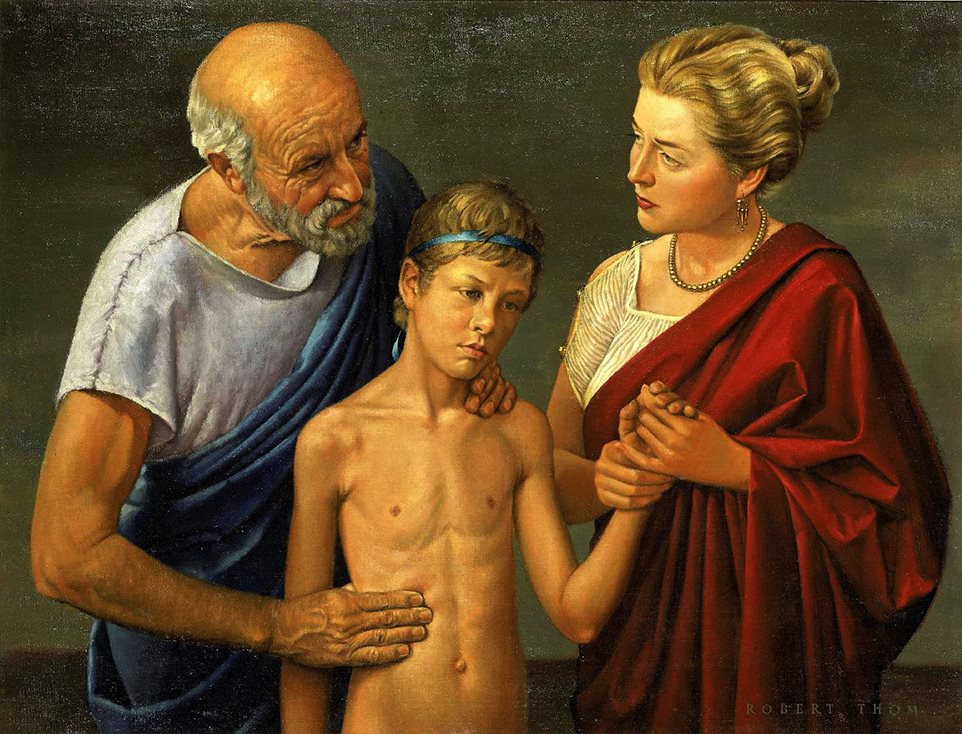Robert Alan Thom (March 4, 1915 – December 31, 1979) was an American illustrator who specialized in the portrayal of historical scenes for commercial patrons. He is perhaps best known for bringing a Rockwellian sensitivity to scenes for his series of 40 paintings depicting the history of pharmacy, and his series of 45 paintings depicting the history of medicine, both commissioned by the Parke-Davis Pharmaceutical Company.
Thom was born in Grand Rapids, Michigan. A student of Robert Brackman, he began his career as a commercial illustrator for General Motors and Detroit Edison in 1939, and set off as an independent artist in 1945. In this role, he produced many series of commissioned paintings for clients such as Kimberly-Clark (scenes from the history of “Graphic Communications Through the Ages”), Illinois Bell (scenes from the history of Illinois), Michigan Bell (scenes from the history of Michigan), and Chevrolet (scenes from the history of baseball). He died in Alma, Michigan.
Thom’s works appear in galleries, museums, and universities worldwide, including the Baseball Hall of Fame and the White House.
The series of 45 paintings devoted to medicine are now archived at the University of Michigan and the series of 40 paintings devoted to pharmacy are said to be archived at Loma Linda University.
“The 45 works, all oil on masonite, range in size up to five feet wide or tall. Thom researched each one meticulously before painting, and traveled to many of the sites depicted. He aimed to show scientific and cultural details as accurately as possible, according to the historical and anthropological knowledge of his day. It is estimated that Thom traveled nearly 250,000 miles through North America and Europe during his research for the series, studying artifacts and locations intently…”
Pfizer made the gift to the University of Michigan, having acquired the paintings when it bought Warner-Lambert, which in turn had purchased Parke-Davis, which at the time was the largest drug company in America and headquartered in Ann Arbor MI, the site of the Medical School.
Jonathan Metzel MD, PhD, Director of their Program in Culture, Health, and Medicine, has written about the paintings in Literature and Medicine.
Where to See
Here’s how to view the collections. I could not find a link at the University of Michigan Museum of Art, but the medical collection is on display at Imgur, complete with annotations from the related book Great Moments in Medicine (text by George Bender) available at the Michigan State University Library and through interlibrary loan.

Hipoocrates – Medicine Becomes a Science
Nor could I find an link at Loma Linda University, but the pharmacy collection can be seen on the archival site celebrating pharmacist Carl F. Hanneman:
“During his nearly six decades as a pharmacist, Carl F. Hanneman got to know a lot of people. He forged good relationships with the many sales reps who called on him at the Mauston Drug Store. Some came to dinner at the Hanneman home, and a few even stayed at the house while in town. One of the long-lasting perks he received from Parke, Davis and Company was a stunning set of lithographs depicting the history of pharmacy. More than 30 prints still exist from Carl’s 1950s collection.”

The Standardization of Pharmaceuticals
Some of the prints can be had at a reasonable price from art.com.
Sources: